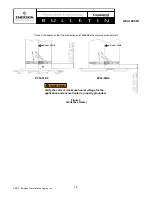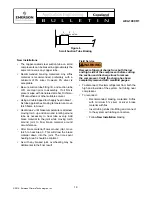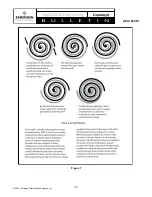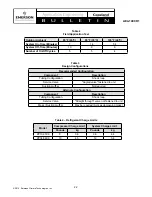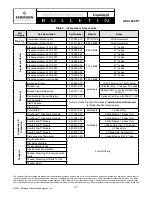
13
© 2015 Emerson Climate Technologies, Inc.
AE4-1400 R1
of the shell. As a result, the motor can be immersed
in refrigerant to a greater extent than hermetic
reciprocating compressors when liquid refrigerant is
present in the shell. In this respect, the scroll is more
like semi-hermetic compressors that have horizontal
motors partially submerged in oil and refrigerant. When
Copeland Scroll compressors are hipot tested with liquid
refrigerant in the shell, they can show higher levels of
leakage current than compressors with the motor on
top. This phenomenon can occur with any compressor
when the motor is immersed in refrigerant. The level of
current leakage does not present any safety issue. To
lower the current leakage reading, the system should
be operated for a brief period of time to redistribute
the refrigerant to a more normal configuration and the
system hipot tested again. See
AE4-1294
for megohm
testing recommendations.
Under no circumstances
should the hipot test be performed while the
compressor is under a vacuum.
Final Run Test
Customers that use a nitrogen final run test must
be careful to not overheat the compressor. Nitrogen
is not a good medium for removing heat from the
compressor, and the scroll tips can be easily damaged
with high compression ratios and/or long test times.
Copeland Scroll compressors are designed for use
with refrigerant, and testing with nitrogen may result in
a situation where the compressor does not develop a
pressure differential (no pump condition). When testing
with nitrogen, the compressor must be allowed to cool
for several minutes between tests.
Single phase scrolls with an electrical nomenclature
of “PFV” (208-230 volt, 1Ø, 60 Hertz) at the end of the
model number are guaranteed to start at 187 volts or
higher and must have a voltage no lower than 197 volts
once the compressor is running under load. All other
compressor voltages, both single and three phase, 50 &
60 Hertz are guaranteed to start and run at 10% below
the lowest voltage shown on the nameplate.
Variable transformers used on assembly lines are often
incapable of maintaining the starting voltage when
larger compressors are tested. To test for voltage sag
during starting, the first compressor in a production
run should be used to preset the voltage. Remove the
start wire from the compressor and apply 200 volts to
the compressor. With the start winding removed, the
compressor will remain on locked rotor long enough
to read the supply voltage. If the voltage sags below
the minimum guaranteed starting voltage, the variable
transformer must be reset to a higher voltage. When
discussing this starting amperage it should be noted
that “inrush current” and locked rotor amps (LRA) are
one and the same. The nameplate LRA is determined
by physically locking a compressor and applying the
highest nameplate voltage to the motor. The amperage
that the motor draws after four seconds is the value that
is used on the nameplate. Since there is a direct ratio
between voltage and locked rotor amperage, the lower
the line voltage used to start the compressor, the lower
the locked rotor amperage will be.
Unbrazing System Components
WARNING
Before attempting to unbraze, it is important to
recover all refrigerant from both the high and low
side of the system.
If the refrigerant charge is removed from a scroll-
equipped unit by recovering one side only, it is very
possible that either the high or low side of the system
remains pressurized. If a brazing torch is then used
to disconnect tubing, the pressurized refrigerant and
oil mixture could ignite when it escapes and contacts
the brazing flame. Instructions should be provided
in appropriate product literature and assembly (line
repair) areas. If compressor removal is required, the
compressor should be cut out of the system rather than
unbrazed.
SERVICE PROCEDURES
Copeland Scroll Compressor Functional Check
A functional compressor test during which the suction
service valve is closed to check how low the compressor
will pull the suction pressure is not a good indication
of how well a compressor is performing.
Such a test
will damage a scroll compressor in a few seconds.
The following diagnostic procedure should be used
to evaluate whether a Copeland Scroll compressor is
functioning properly:
1.
Proper voltage to the unit should be verified.
2. Determine if the internal motor overload has
opened or if an internal motor short or ground
fault has developed. If the internal overload has
opened, the compressor must be allowed to cool
sufficiently to allow it to reset.


















